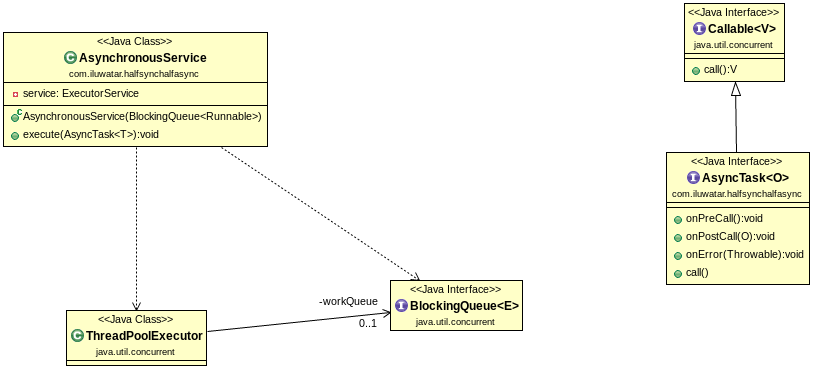Half-Sync/Half-Async
Intent
The Half-Sync/Half-Async pattern decouples synchronous I/O from
asynchronous I/O in a system to simplify concurrent programming effort without
degrading execution efficiency.
Class diagram

Applicability
Use Half-Sync/Half-Async pattern when
- a system possesses following characteristics:
- the system must perform tasks in response to external events that occur asynchronously, like hardware interrupts in OS
- it is inefficient to dedicate separate thread of control to perform synchronous I/O for each external source of event
- the higher level tasks in the system can be simplified significantly if I/O is performed synchronously.
- one or more tasks in a system must run in a single thread of control, while other tasks may benefit from multi-threading.
Explanation
The Half-Sync/Half-Async pattern is a concurrency design pattern used in software engineering to manage concurrent operations and interactions in a system. It's particularly useful in applications where both asynchronous and synchronous processing are required to achieve optimal performance and responsiveness.
The pattern is structured into two components: the synchronous part (Half-Sync) and the asynchronous part (Half-Async).
Half-Sync (Synchronous Part):
In this part, there is a synchronous layer that handles high-level control flow and coordination of the application. It typically consists of a set of threads that handle communication, synchronization, and coordination. These threads are responsible for managing shared resources and orchestrating the flow of work in a synchronous manner.
Half-Async (Asynchronous Part):
The asynchronous part involves a set of asynchronous workers or threads that perform the actual processing and execution of tasks. These threads are responsible for carrying out time-consuming or potentially blocking operations asynchronously. They handle I/O operations, long-running computations, or any task that can be parallelized effectively.
How it Works:
Synchronous Part:
The synchronous part handles incoming requests, organizes the tasks to be performed, and dispatches them to the asynchronous workers.
It's responsible for high-level orchestration, resource management, and synchronization of the overall system.
Asynchronous Part:
Asynchronous workers execute the tasks independently and concurrently without blocking the main application.
They handle time-consuming or I/O-bound tasks efficiently, ensuring the system remains responsive.
Advantages:
Responsiveness: Asynchronous processing ensures that the system remains responsive by allowing non-blocking operations.
Parallel Execution: It enables concurrent execution of tasks, improving performance by utilizing multiple threads or processes.
Scalability: The asynchronous part can be scaled easily to handle a larger number of requests efficiently.
Disadvantages:
Complexity: Implementing and managing the two parts can be complex, requiring careful coordination and synchronization mechanisms.
Potential Deadlocks: The interplay between the synchronous and asynchronous parts can introduce potential deadlocks or race conditions if not handled correctly.
The Half-Sync/Half-Async pattern strikes a balance between responsiveness and efficiency by utilizing both synchronous and asynchronous processing to optimize the performance of a system while ensuring responsiveness to user requests.
Programmatic Example
{
import java.util.LinkedList;
import java.util.Queue;
class TaskQueue {
private Queue<String> queue = new LinkedList<>();
synchronized void enqueue(String task) {
queue.add(task);
notify(); // Notify waiting threads that a task is available
}
synchronized String dequeue() throws InterruptedException {
while (queue.isEmpty()) {
wait(); // Wait until a task is enqueued
}
return queue.poll();
}
}
class SynchronousPart extends Thread {
private TaskQueue taskQueue;
public SynchronousPart(TaskQueue taskQueue) {
this.taskQueue = taskQueue;
}
@Override
public void run() {
while (true) {
try {
String task = taskQueue.dequeue();
System.out.println("Synchronous part processing task: " + task);
// Simulate some synchronous processing
Thread.sleep(1000);
} catch (InterruptedException e) {
Thread.currentThread().interrupt();
}
}
}
}
class AsynchronousPart extends Thread {
@Override
public void run() {
while (true) {
// Simulate some asynchronous processing
System.out.println("Asynchronous part processing tasks...");
try {
Thread.sleep(500);
} catch (InterruptedException e) {
Thread.currentThread().interrupt();
}
}
}
}
public class HalfSyncHalfAsyncExample {
public static void main(String[] args) {
TaskQueue taskQueue = new TaskQueue();
SynchronousPart synchronousThread = new SynchronousPart(taskQueue);
AsynchronousPart asynchronousThread = new AsynchronousPart();
synchronousThread.start();
asynchronousThread.start();
// Enqueue tasks
taskQueue.enqueue("Task 1");
taskQueue.enqueue("Task 2");
taskQueue.enqueue("Task 3");
// Allow the threads to run for a while
try {
Thread.sleep(5000);
} catch (InterruptedException e) {
Thread.currentThread().interrupt();
}
// Stop the threads (in a real application, you would have a proper way to signal the threads to stop)
synchronousThread.interrupt();
asynchronousThread.interrupt();
}
}
In this Java example:
- TaskQueue class manages the task queue and provides methods for enqueueing and dequeuing tasks in a thread-safe manner.
- SynchronousPart and AsynchronousPart classes represent the synchronous and asynchronous parts of the application, respectively.
- The synchronous part processes tasks in a synchronous manner, and the asynchronous part processes tasks in an asynchronous manner, simulating some processing time.
- The main program creates instances of TaskQueue, SynchronousPart, and AsynchronousPart, enqueues tasks, and starts the threads to demonstrate the Half-Sync/Half-Async pattern.